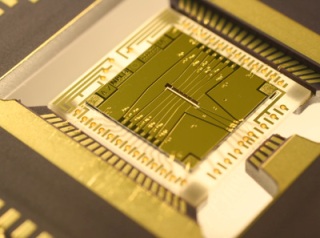Jul 26 2017
An international team of Researchers, including the National Physical Laboratory (NPL), have developed a new method for making phosphorous atoms 'dance', which could bring quantum computers a step closer to practical applications. The team was headed by Professor Ben Murdin and Dr Steve Chick from the University of Surrey.
 A microtrap chip for quantum computing research, developed by NPL in 2012 (Credit: National Physical Laboratory)
A microtrap chip for quantum computing research, developed by NPL in 2012 (Credit: National Physical Laboratory)
According to the study that appeared in Nature Communications, the Scientists successfully manipulated phosphorous atoms inside the silicon crystals and controlled their size and shape, basically making them dance. This study could well be the next breakthrough in the field of quantum computers.
So far, materials that are not produced on large scale and atoms that are suspended in mid-air were traditionally used to make most quantum computers. However, the research team uses technology where single atoms of phosphorous are trapped within the silicon crystals, which are the two elements used for making existing computer chips. The Researchers believe that if these atoms are positioned in a fixed grid structure, it could lead to more reliable quantum computers. In the strategy known as 'surface code' quantum computing, many atoms are placed in a fixed grid and the atoms’ dancing motion is used to control their interactions.
A series of switches known as transistors are used by modern computers to perform important computing functions such as storing data and processing that data. In quantum computers, that data is stored and processed using atoms, which can be both 'on' and 'off' simultaneously due to quantum mechanics. This enables quantum computers to process more amounts of information than current generation of computers.
Our experiment showed that we can control the shape and size of the phosphorous atoms and make them dance around. Our intention is to take advantage of this behavior to make 'gates', to control when and how the quantum computer works. Our advanced control will help make our quantum computers more reliable, even if they occasionally make mistakes.
Classical computers already use ways of recovering from mistakes, but in quantum computers it's a much more difficult problem. We also hope that using materials which are already popular in computing will allow quantum computers and current computers to be compatible with each other.
Dr Steve Chick, the University of Surrey
In addition to the University of Surrey and NPL, the study also involved researchers from University College London, Radboud University (the Netherlands), ETH Zurich (Switzerland) and Heriot-Watt University.